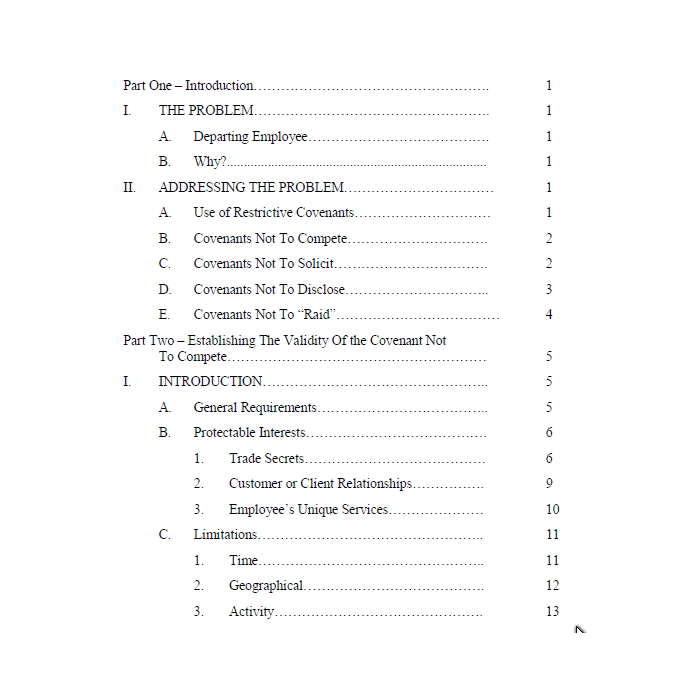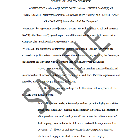Covenants By Employees: How To Enforce Them (125-Page Book)
Released July 8, 2010 - Written by Michael J. Hutter, Esq.
Click the above "Learn More" button to read the Table of Contents, several Sample Pages and Mr. Hutter's curriculum vitae.
See sample pages above for the complete Table Of Contents. Alternatively, here are the main topics covered in this book:
Part One – Introduction
I. THE PROBLEM
A. Departing Employee
B. Why?
II. ADDRESSING THE PROBLEM
A. Use of Restrictive Covenants
B. Covenants Not To Compete
C. Covenants Not To Solicit
D. Covenants Not To Disclose
E. Covenants Not To “Raid”
Part Two – Establishing The Validity Of the Covenant Not
To Compete
I. INTRODUCTION
A. General Requirements
B. Protectable Interests
1. Trade Secrets
2. Customer or Client Relationships
3. Employee’s Unique Services
C. Limitations
1. Time
2. Geographical
3. Activity
D. Related Matters
1. Blue-Pencil Rule
2. Employee Choice Doctrine
E. Special Situations
1. Physicians and Healthcare Industry
2. Accountants
3. Broadcasters
4. Attorneys
Part Three – Enjoining The Ex-Employee Who Violates A
Valid Covenant Not To Compete
I. INTRODUCTION
A. Need For Preliminary Injunctive Relief
B. Nature Of Preliminary Injunctive Relief
C. Requirements For Preliminary Injunctive Relief
II. ELEMENTS
A. Irreparable Harm
B. Serious Questions/Balancing The Hardships
C. Pre-Litigation Inquiries
III. COVENANTS NOT TO DISCLOSE
A. Introduction
B. Inevitable Disclosure Doctrine
C. Establishing Inevitable Disclosure
IV. COMMON DEFENSES
A. Independent Development
B. Unclean Hands
C. Waiver
V. FRAMING THE INJUNCTION
A. Generally
Part Four – Recurring Litigation Issues
I. CONTROLLING LAW AND FORUM
A. Controlling Law
B. Choice Of Forum Clause
C. Parallel Litigation and The Race To The Courthouse
II. IDENTIFYING THE TRADE SECRET
A. Generally
III. PROTECTIVE ORDERS
A. Generally
IV. DISCOVERY ISSUES
A. Expedited Discovery
B. Electronic Data
C. Inadvertent Disclosure
D. Company Computer
V. BOND
A. Generally
Part Five – Additional Claims
I. COMPUTER FRAUD AND ABUSE ACT
A. Generally
II. ECONOMIC ESPIONAGE ACT
A. Generally
Part Six – Related Concerns
I. PREPARING TO COMPETE WITH A FORMER
EMPLOYER
A. Pre-Departure Conduct
B. Legal Advice
II. HIRING THE NEW (PROSPECTIVE) EMPLOYEE
A. Ascertain Nature Of Current Duties
B. Obtain And Scrutinize Employment Agreements
C. Ability To Design Appropriate Safeguards If Hired?
D. Other Issues
Related Form(s): links to related Forms on this site appear immediately after the below "Author" curriculum vitae.
Related CLE Course: to listen to, and obtain CLE/MCLE credits in those states for which it is listed, please visit our sister site, www.nlfonline.com, click on your state and scroll to this title under the "Employment/Labor Law" heading: "Covenants By Employees: How To Enforce Them".
Author:
Michael J. Hutter is a Professor of Law at Albany Law School, where he has been a member of the faculty since 1976. He is also Special Counsel to the Albany law firm of Powers & Santola, LLP.
Professor Hutter is an honors graduate of Brown University, and Boston College Law School. In law school he was the Editor-In-Chief of Boston College’s law review, and was elected to the Order of the Coif. After graduation, Professor Hutter served as law clerk to Judge Matthew J. Jasen, an Associate Judge of the New York Court of Appeals. From 1979-1984, he was the Executive Director of the New York State Law Revision Commission. In 1999, Professor Hutter was selected as one of seven nominees to the Court of Appeals by the State Commission on Judicial Nomination. He presently serves as a Commissioner on the New York State Law Revision Commission and as Chair of the Board of Directors of the Capital Defender Office.
Professor Hutter’s teaching areas include Evidence, Trial Practice, Intellectual Property, and Trade Regulation. In his practice, he specializes in appellate practice. He has argued over 300 appeals in all of New York’s appellate courts, state and federal, and many of the cases in which he represented the prevailing party are landmark decisions.


